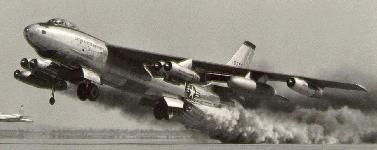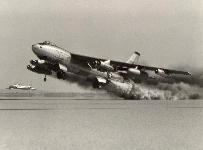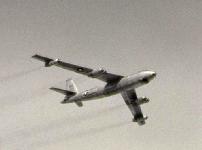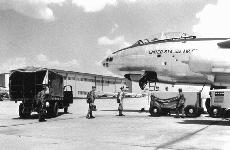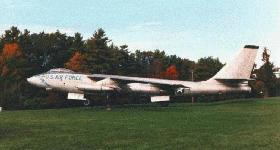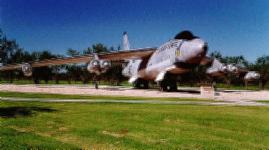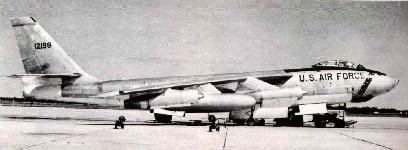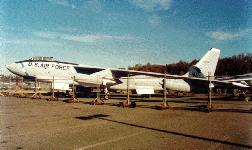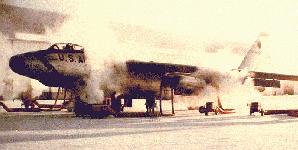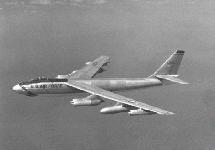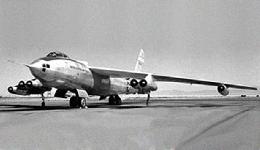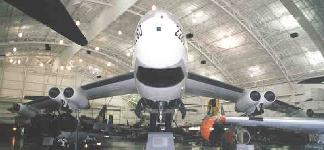





B-47 research and development began in 1945 with the first prototype flight in December 1947. The Air Force wanted a high-altitude, medium-range, subsonic bomber. At that time, four contractors were developing bombers. Two designs were conventional bombers in the mold of the B-29, while the more radical designs were the Northrop flying wing and the Boeing swept wing jet. In this era before the SAM, fighter aircraft were considered the main threat to bombers. World War II had shown that stripped down B-29's with near-fighter speed and a higher altitude ceiling could only be successfully intercepted from the rear.
With the speed and maneuverability of the fighters of the late forties, Boeing's swept-wing XB-47 won the bomber competition and swiftly transformed the XB-46 and the XB-48 into aviation footnotes. Six Allison J35-2 turbojet engines slung in pods beneath the swept-back wings gave the prototype Stratojet nimble performance, and helped to validate a design concept still widely used today. Although uprated J47-GE-3s were soon substituted, the B-47 also carried mountings for 18 solid-fuel booster rockets in the aft fuselage to shorten the takeoff roll. Flight testing continued through 1951, and B-47's began entering the inventory in 1952. ICBMs and SLBMs did not yet exist, and the penetrating bomber was the only nuclear strike vehicle available. A total of 2,039 B-47's were funded and built in a serial production that lasted until 1956.
The B-47 was the first pure jet strategic bomber whose many unique features included six jet engines; a two-engine, pylon-mounted pod under each wing near the fuselage; and a single-engine pod further outboard. The wings were attached high on the fuselage and swept 35. The design incorporated a revolutionary bicycle-type, retractable main landing gear with single, two-wheel struts on the forward and aft fuselage. Outrigger wheels added lateral stability and retracted into the two-engine pod cowling. The B-47 was 107 feet long, 28 feet high at the tail, and had a wing span of 116 feet. The crew consisted of a pilot, copilot, and bombardier. With a maximum gross weight of about 204,000 pounds, it used rocket assist on takeoff. A tail chute was used to slow down the aircraft during landings.
Although heavier than the heaviest World War II bomber, the B-47 was designed to be a medium-range penetrator with approximately a 3,500-nm range. This was not a problem in the early 1950's since forward basing was available in the United Kingdom, Spain, Morocco, Guam, and Alaska. In addition, the B-47 was equipped with an air refueling capability and, on several occasions, 36-hour missions were flown. Thus, when it initially entered the inventory, its range was sufficient.
The aircraft's payload capacity was limited to 20,000 pounds internally. Since nuclear weapons were large in the early 1950's, the bomb bay was limited to one or two of high yield. But this lack of payload capacity was compensated for by the large numbers of B-47's that were purchased (at a cost of less than $2 million per airplane) which resulted in an acceptable overall weapon delivery capacity. The B-47 was also capable of carrying 13 500-pound or 8 1,000-pound conventional bombs.52 Although no B-47 squadron was ever equipped with any type of missile, the B-47 was used on several occasions as a test aircraft for missile launches. The biggest aid to the B-47 payload was nuclear weapon technology which developed smaller weapons.
Serial production made incorporating changes easier; the most numerous models were the B and E series. There were many production improvements made to include more powerful engines with water injection, the addition of tail guns, ejection seats, increased maximum gross weight, and bomb bay modifications for new weapons technology. Once deployed, modifications were numerous. The most significant was the structural revision to convert the B-47 from a high to a low altitude penetrator due to the development of Soviet SAMs in the mid 1950's. In May 1960, Gary Powers' U-2 was shot down by a Soviet SAM, vividly demonstrating Soviet high altitude defense capabilities.
Besides structural modifications, ECM and other avionics were updated. Some B-47's were modified into reconnaissance and other specialized aircraft. Since space was a limitation, most aircraft modified for reconnaissance and special missions were not capable of carrying bombs. However, the RB-47B could be converted back to a bomber. The B-47 had the capability to be modified but was restricted by space limitations.
By 1956, B-47 deployment reached its peak with over 1,300 assigned to SAC. In addition about 250 RB-47s were in SAC at that time. Subsequently, phase out of the B-47 took place in the 1960s. In 1960 there were still almost 1,100 B-47s. This dropped to about 400 in 1964 and in 1966 the last B-47 had been phased out though a few RB-47s were retained until 1967. The phase out of the B-47 medium bomber coincided with the rapid build up of ICBM and SLBM deployment by the US.
The B-47's were phased out in the early 1960's with the last ones leaving the inventory by the end of 1965. The B-47 had shown flexibility in adapting to a low level mission profile that was required by the introduction of SAMs. But modifications to a large fleet (especially structural modifications) cost vast sums of money. Moreover, forward basing of strategic nuclear forces was becoming unpopular with our allies, and there was not enough tanker support to make up the range difference for CONUS basing of all the B-47's. The B-58, planned as a replacement for the B-47, started entering the inventory in 1960. Also, the B-52, designed as an outgrowth of the B-47, was proving to be a very capable strategic bomber. Thus, the combination of mission profile changes, which limited B-47's usefulness and the emergence of a replacement medium-range bomber and a truly long-range strategic bomber, led to the retirement of the B-47's after 14 years of service.
In summary, the B-47 was a technological innovation in bomber aircraft design with swept wings, jet engines, the ability to be air refueled, and an operational envelope equal to the fighter aircraft of the early 1950's. The Stratojet was also one of the more beautiful airplanes to grace America's skies. However, it was a medium-range bomber that had limitations on space, payload, and range. When deployed, the B-47 was adequate to perform its designed mission. While it was able to adapt to changes in the threat at significant cost, it was not able to keep up with a heightened threat and greater range requirements, thus making other available aircraft that did the job better more viable.
Specifications |
|
| Manufacturer: | Boeing Aircraft Company (primary), Douglas and Lockheed |
| Designation: | B-47 |
| Version: | B-47E-IV (Heavyweight modification) |
| Nickname: | Stratojet |
| Type: | Bomber |
| Crew: | 3 - Pilot, Copilot, Navigator |
| Weights [lbs]: | Empty - 79,074 Combat - 133,030 Takeoff - 230,000 (limited by landing gear strength) |
| No. of Engines: | 6 |
| Powerplant: | General Electric J-47-GE-25 turbojet engines; JATO (Jet Assisted Take-Off) using auxiliary rocket motors that are jettisoned after take-off. |
| Thrust (each): | 7,200 lbs |
| Takeoff ground run (feet) |
Sea level - 10,400 Sea level, jet assisted - 7,350 Over 50-ft obstacle - 12,000 Over 50-ft obstacle, jet assisted - 8,800 |
| Combat Speed: | 557 mph at 38,500 ft 435 mph (average) |
| Max Speed: | 600 mph |
| Rate of climb |
Sea level - 1,850 feet per minute Combat rate (Maximum power) - 4,350 feet per minute |
| Service Ceiling: | 40,500 ft 29,500 (100 feet per minute climb) 36,900 at combat weight (100 feet per minute climb) 39,300 - combat ceiling (500 feet per minute climb) |
| Combat radius | 2,050 nautical miles |
| Tail Guns: | 2 - .20mm cannons in remote tail turret |
| Bombs (internal) | 20,000 - 25,000 lbs |
